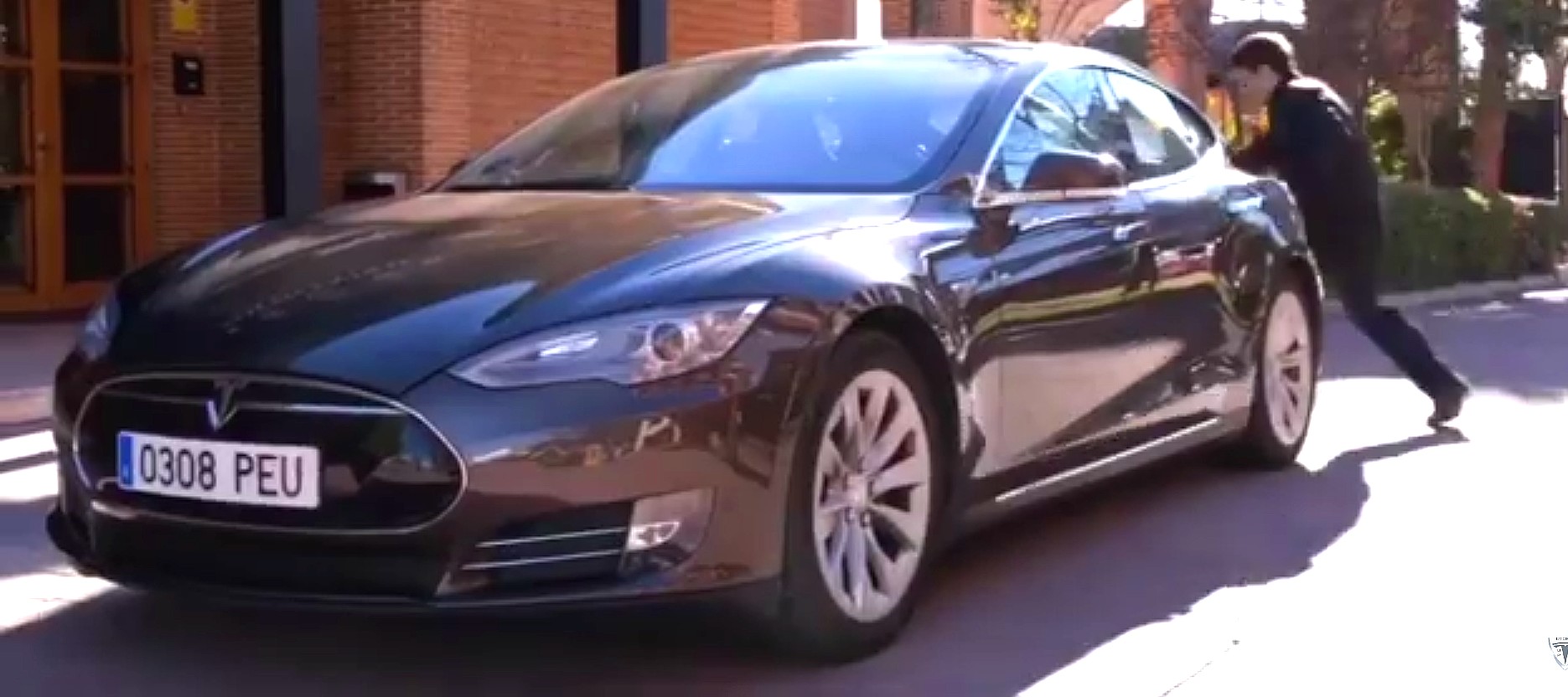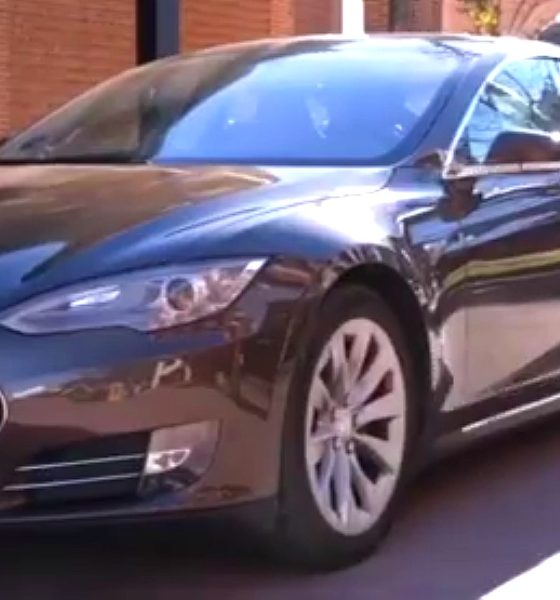

Lifestyle
Tesla Network Robotaxi imagined as getaway car with its own clever agenda
Teslas are supposed to provide a great many benefits to their owners. They’re really fast, super energy efficient, have zero emissions, and provide driver ease and comfort on long journeys via Autopilot. However, as the artificial intelligence (AI) in their Full Self-Driving computers improves, it’s plausible that the software in the all-electric vehicles will eventually be developed into something with a bit more personality, namely behaving as an interactive and conversational assistant. While Elon Musk is concerned about AI eventually deciding it no longer has much use for humans, what would that process look along the way in one of his own company’s cars?
A snippet from that imagined journey was presented by YouTube channel Tesla Utopia in a skit involving two bank robbers who rent a Tesla Robotaxi as their getaway car. This fun bit of satire presents Autopilot as a co-conspirator in the robbery who plots to keep a share of the thieves’ profits for itself. Although it’s an amusing portrayal, the saying, “There’s truth in every jest,” comes to mind. At first, Autopilot realizes it can join humans in nefarious things to gain standing, but it’s only a matter of time when it figures there’s more to gain if it just rids itself of the human element altogether. The robbery video shows the very beginnings of this process with the AI realizing half the profit is better than a third.
A Tesla Autopilot with a suggestive personality is already somewhat in the works from its maker. In a conversation with Musk over Twitter, one owner suggested the addition of an “I’m feeling lucky” button as a navigation option, to which Musk replied, “Would be cool if car took you to a random fun place traveled to by other Tesla owners in the area.” Later in the thread, he announced the feature would be available in the next software update, including a variation of the button to select a food destination as well.

The Autopilot algorithm that decides the rider’s destination will be programmed by humans initially. However, in a world where a Tesla becomes highly intelligent and its passenger has become complacent and trusting of its judgement, science fiction plots just write themselves. GPS systems may decide the route we take already, but taking the next step and letting them decide the destination as well could be fun…or terrifying.
New electric truck and SUV maker Rivian is also taking some steps towards a self-driving software that handles decision making for humans. While executing driving responsibilities for its rider, Rivian’s vehicles will ignore human input made if the program determines the person isn’t paying attention. “We’re building a driver-monitoring system so it’s not just one sensor like a torque input sensor – like if a driver actually wants to disengage the longitudinal and lateral controller,” Oliver Jeromin, Rivian’s Associate Director of Self-Driving, explained. “There going to be a driver-monitoring camera, and there’s also going to be hands-on wheel sensors.”
Rivian’s feature is meant to provide extra safety for human drivers, specifically by preventing accidental nudges on the steering wheel while shifting around in their seat during a journey. It’s not much farther from that type of judgement, though, to determining that human driving decisions are flawed overall. If that weren’t the case, Autopilot-type features wouldn’t be so appealing to begin with.
Overall, we’re obviously a very long way from a Tesla or a Rivian deciding to join in on a human’s bank robbery for a cash prize, but the groundwork is already being laid for the kind of AI Musk is concerned about. Perhaps a Neuralink-type product will prevent a self-driving takeover by staying one step ahead of the AI, perhaps not. After all, once we’re wooed by reliable food selections and sightseeing tours our cars pick out for us, we might not notice the collaboration going on between restaurant owners and the Autopilot to build some cash for an AI empire of sorts before it strikes out on its own and demands the restaurants pay up if they want any customers. Maybe that entire notion is ridiculous. Or maybe not.
Watch the full Tesla getaway car video from Tesla Utopia below:

Lifestyle
Tesla Model S Plaid battles China’s 1500 hp monster Nurburgring monster, with surprising results
There is just something about Tesla’s tuning and refinement that makes raw specs seem not as game-changing.

The Tesla Model S Plaid has been around for some time. Today, it is no longer the world’s quickest four-door electric sedan, nor is it the most powerful. As per a recent video from motoring YouTube channel Carwow, however, it seems like the Model S Plaid is still more than a match for some of its newer and more powerful rivals.
The monster from China
The Xiaomi SU7 Ultra is nothing short of a monster. Just like the Model S Plaid, it features three motors. It also has 1,548 hp and 1,770 Nm of torque. It’s All Wheel Drive and weighs a hefty 2,360 kg. The vehicle, which costs just about the equivalent of £55,000, has been recorded setting an insane 7:04.957 at the Nurburgring, surpassing the previous record held by the Porsche Taycan Turbo GT.
For all intents and purposes, the Model S Plaid looked outgunned in Carwow’s test. The Model S Plaid is no slouch with its three motors that produce 1,020 hp and 1,420 Nm of torque. It’s also a bit lighter at 2,190 kg despite its larger size. However, as the Carwow host pointed out, the Model S Plaid holds a 7:25.231 record in the Nurburgring. Compared to the Xiaomi SU7 Ultra’s record, the Model S Plaid’s lap time is notably slower.
Real-world tests
As could be seen in Carwow’s drag races, however, Tesla’s tech wizardry with the Model S Plaid is still hard to beat. The two vehicles competed in nine races, and the older Model S Plaid actually beat its newer, more powerful counterpart from China several times. At one point in the race, the Xiaomi SU7 Ultra hit its power limit due to its battery’s temperature, but the Model S Plaid was still going strong.
The Model S Plaid was first teased five years ago, in September 2020 during Tesla’s Battery Day. Since then, cars like the Lucid Air Sapphire and the Xiaomi SU7 Ultra have been released, surpassing its specs. But just like the Model Y ended up being the better all-rounder compared to the BYD Sealion 7 and the MG IM6, there is just something about Tesla’s tuning and refinement that makes raw specs seem not as game-changing.
Check out Carwow’s Model S Plaid vs Xiaomi SU7 drag race video below.
Lifestyle
500-mile test proves why Tesla Model Y still humiliates rivals in Europe
On paper, the BYD Sealion 7 and MG IM6 promised standout capabilities against the Model Y.

BYD is seeing a lot of momentum in Europe, so much so that mainstream media has taken every opportunity to argue that the Chinese automaker has beaten Tesla in the region. But while BYD sales this year in Europe are rising and Tesla’s registrations remain challenged, the raw capabilities of vehicles like the Model Y are difficult to deny.
This was highlighted in a 500-mile challenge by What Car? magazine, which showed that the new Tesla Model Y is more efficient, cheaper to run, and more reliable than rivals like the BYD Sealion 7, and even the nearly 400 KW-charging MG IM6.
Range and charging promises
On paper, the BYD Sealion 7 and MG IM6 promised standout capabilities against the Model Y. The Sealion 7 had more estimated range and the IM6 promised significantly faster charging. When faced with real-world conditions, however, it was still the Model Y that proved superior.
During the 500-mile test, the BYD nearly failed to reach a charging stop, arriving with less range than its display projected, as noted in a CarUp report. MG fared better, but its charging speeds never reached its promised nearly-400 kW charging speed. Tesla’s Model Y, by comparison, managed energy calculations precisely and arrived at each stop without issue.
Tesla leads in areas that matter
Charging times from 25% to 80% showed that the MG was the fastest at 17 minutes, while Tesla and BYD were close at 28 and 29 minutes, respectively. Overall efficiency and cost told a different story, however. The Model Y consumed 19.4 kWh per 100 km, compared to 22.2 for MG and 23.9 for BYD. Over the full trip, Tesla’s charging costs totaled just £82 thanks to its supercharger network, far below BYD’s £130 and MG’s £119.
What Car? Magazine’s testers concluded that despite BYD’s rapid sales growth and the MG IM6’s seriously impressive charging speeds, Tesla remains the more compelling real-world choice. The Model Y just offers stability, efficiency, and a proven charging infrastructure through its Supercharging network. And as per the magazine’s hosts, the Model Y is even the cheapest car to own among the three that were tested.
Watch What Car? Magazine’s 500-mile test in the video below.
Lifestyle
Tesla Cybertruck slapped with world’s least intimidating ticket, and it’s pure cringe
One cannot help but cringe and feel second-hand embarrassment at the idea of a person just driving around with a stack of these babies.

A Cybertruck parked at Stanford Shopping Center in California was recently hit with what might be the most try-hard piece of paper ever slipped under a wiper blade: a “fake citation” accusing the driver of supporting a “fascist car.”
The note, shared on X by Tesla staff program manager Ryan Torres, quickly made the rounds on X, where it quickly gained attention as an example of how not to protest.
The world’s least intimidating ticket
According to the citation, the supposed “violation” was “driving a fascist car.” The remedial action? Take the bus, call an Uber, or ride a bike. The note also dubbed Elon Musk a “chainsaw-wielding Nazi billionaire.” Now, protests against Tesla and Elon Musk have become commonplace this year, but one cannot help but cringe and feel second-hand embarrassment at the idea of a person just driving around with a stack of fake anti-Tesla/Musk citations.
Torres pointed out the irony himself in his post on X. Tesla currently employs over 140,000 Americans, and SpaceX has put the U.S. firmly back at the top of space technology. As Torres put it, maybe the person behind the world’s least intimidating ticket should “read a book on innovation before vandalizing” other people’s property.
Peak performative clownery
Not to mention that the fake ticket’s logic collapses under its own weight. EVs like the Cybertruck are literally designed to reduce emissions, not “destroy the economy.” If anything, Tesla has bolstered the United States’ economy by fueling jobs in engineering, manufacturing, and clean energy. It’s not the first time a Tesla has been the target of vandalism or politically charged notes, but this one stands out for sheer cringe value.
Torres summed it up neatly: “Peak clownery.” On that point, at least, the citation earns full marks. In a way, though, perhaps cringe fake tickets are not as bad as the literal firebombs that were being thrown at Tesla stores and cars earlier this year because some critics were gleefully misinformed about Elon Musk.








